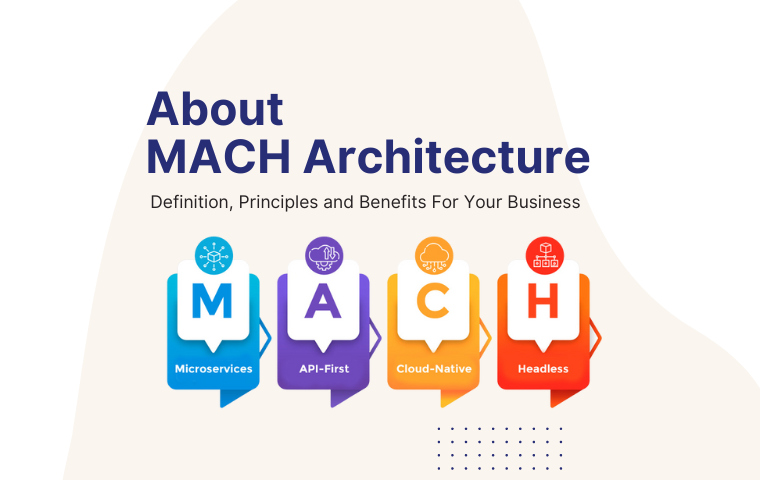TABLE OF CONTENT
Definition: What is MACH Architecture?
Principles of MACH Architecture
4 Key Benefits: How MACH Architecture Helps
Some Challenges when Using MACH Architecture You Must Know
Case Studies of Using MACH Architecture
Conclusion
Definition: What is MACH Architecture?
MACH architecture is an acronym for four constituent elements: Microservices, API-first, Cloud-native and Headless. The birth of MACH architecture is said to solve limited problems that traditional operational architecture cannot fix.
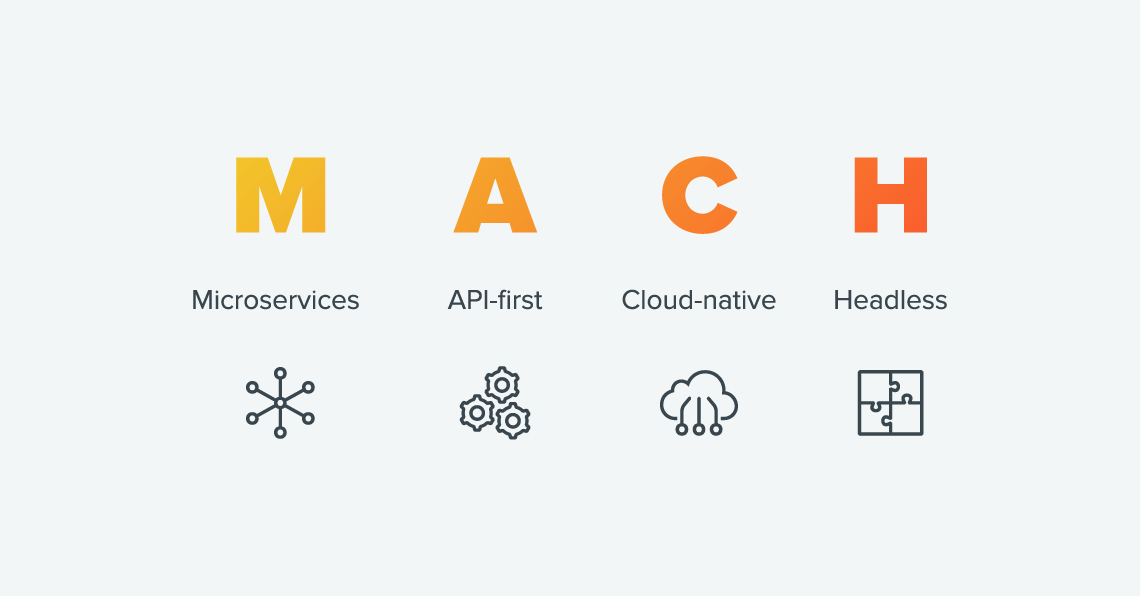
In particular, this becomes more urgent than ever for ecommerce businesses when they begin to scale rapidly and the number of customers increases dramatically. No business owner wants to face challenges such as: the slow implementation process, difficulty integrating technology and new trends in the market, and the inability to personalize the user experience optimally and efficiently.
Fortunately, MACH architecture can handle all of those problems. This architecture allows businesses to operate flexibly and with superior scalability by applying microservices, API-first design, cloud-based infrastructure and headless commerce capabilities.
Unlike traditional or monolithic architecture, MACH creates conditions for businesses to quickly adapt to many changes, responding to new trends appearing in the market easily.
At the same time, proactive impacts from the business side or errors that arise will not seriously affect the overall system, and customer experience will also be built in a personalized form.
You can see the core differences between MACH architecture and Monolith architecture in the table below:
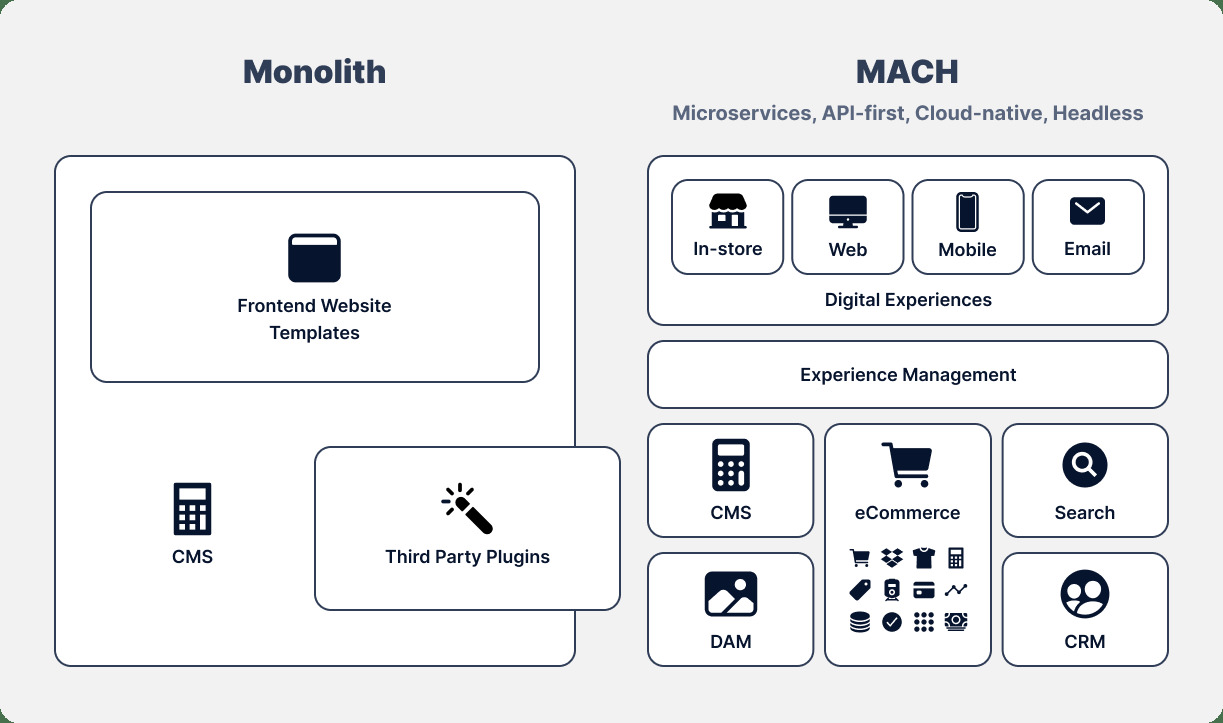
| Aspects | MACH architecture | Monolith architecture |
| Structure | Microservices, each one represents a different task | Works consistently based on a single code base system |
| Ability of extension | Outstanding scalability, each microservice can be influenced and developed based on business needs | Limited by operating as one unit, expansion can become difficult and complicated |
| Deployment process | Continuous deployment is possible with each microservice | Implementing any process requires testing and updating the entire application |
| Integration | Seamless and diverse integration thanks to API-first elements | Integration can be complicated due to the need to test compatibility with all components of the new application’s system |
| Development speed | Faster, each microservice can work independently for the same amount of time | Slower because development is dependent on a single codebase |
| Pricing | It may be higher due to investment in the operation of each different microservice | It will be lower initially but maintenance costs will become higher over time |
| Fault recovery and isolation | Errors in a certain microservice will not affect the operation of the entire system | A small error can have a serious impact and potentially bring down the entire ecommerce store system |
| User experience | User experience can be personalized and developed differently depending on the actions of each business | Less flexible, slow and more difficult to update when wanting to upgrade customer experience |
You can also view this related article:
MACH Architecture vs Microservice: Challenges and Best Solutions
Principles of MACH Architecture
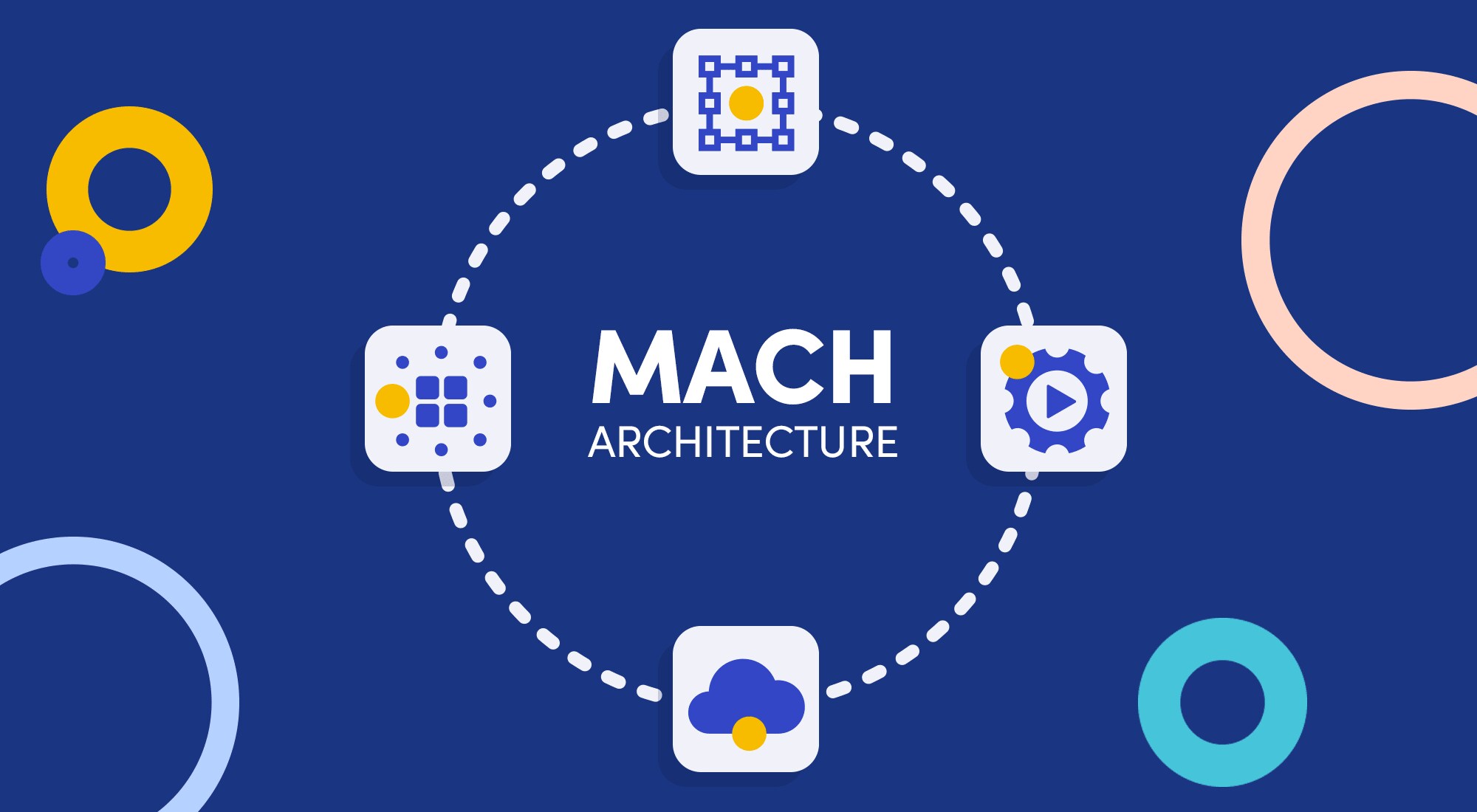
M - Microservices
Microservices are one of the pillars that make up the distinctive features of MACH architecture. They divide the entire ecommerce business system into many small microservices that can operate independently. Each microservice is responsible for a specific function throughout the business process, such as payment gateway, ecommerce checkout or product catalog management, user authentication.
Operating based on the modular nature and independent functioning of each individual service, microservices are an important fulcrum for ecommerce businesses to accelerate the development and update process.
An obvious example: if your ecommerce store needs to scale in terms of product offerings, it can be a big deal to use a monolithic architecture. You need to consider how this addition or subtraction process impacts other elements of your store, from engineering to the front-end. However, with microservices of MACH architecture, this can be done right when you want without affecting other activities such as content creation or user authentication.
With microservices-based architecture in ecommerce, business owners can also freely choose the appropriate programming language, operating framework, and database for each different microservice. Independence and technological flexibility ensure ecommerce businesses quickly adapt to different changes and trends in the market, maintaining a competitive advantage.
A - API-first
API is considered the guiding principle in the core way MACH architecture works. It ensures every feature and functionality of an ecommerce business can be accessed through standardized APIs. Seamlessness between services is an essential factor to maintain regular and consistent operations of businesses on ecommerce platforms.
For businesses growing rapidly across ecommerce platforms, an API-first of MACH architecture approach ensures seamless interoperability with both internal and external applications. In other words, it plays the role of binding all microservices together like a bridge, enabling each component to develop independently but still coordinate harmoniously in an overall system.
For example, when a customer submits authentication information on your ecommerce website, the microservice in charge of this item will automatically receive the information with the help of API, then send back a Yes or No answer to the customer. Two-way interaction allows for seamless in-store communication, ensuring a smooth and easy login process.
APIs also allow the integration of external applications or functions without disrupting the operations of your ecommerce store or negatively affecting the overall system. You can easily make various service changes to optimize the customer experience.
C - Cloud-native
Cloud-native in MACH architecture focuses on using cloud computing to enhance scalability, improve flexibility and resilience of ecommerce stores. Development services are deployed in the cloud, taking full advantage of features such as distributed computing, auto-scaling and always-on availability.
The cloud-native approach of MACH architecture allows businesses to quickly deploy updated versions at specific intervals, continuously accelerating the delivery and operations process. Additionally, cloud-centric platforms will have superior self-healing capabilities and built-in fault tolerance. Businesses operating on ecommerce platforms can maintain regular operations with fast response speeds, even in the event of unexpected errors.
Another important element of cloud-native is that you only pay for the resources you actually use. For example, during off-peak periods, businesses can scale back resources to minimize costs. This flexibility of MACH architecture allows business owners to be proactive in controlling costs, while optimizing operations exactly according to the plan and budget decided from the beginning.
H - Headless
The headless principle of MACH architecture emphasizes separating the front-end presentation layer from the back-end logic. In a headless approach, the front-end (“head”) is completely separated from back-end services and data. They will communicate through APIs. This separation allows the flexibility to deliver content and develop functionality for users across multiple platforms and channels, such as mobile apps, websites or IoT devices.
At this stage, ecommerce businesses can use the latest technologies and frameworks without facing certain limitations from the back-end system. Specifically, if your business wants to redesign its online store to improve user engagement or optimize for mobile devices, you won’t need to worry about infrastructure issues. This allows ecommerce businesses to accelerate the development process in the fastest time, surprising the customer experience.
Because the front-end and back-end are decoupled, their content can be seamlessly integrated into different platforms, ensuring a consistent customer experience whether online shopping is performed on any device.
After all, you can view this overview table about principles of MACH architecture and their pros and cons:
| Principle | Pros | Cons |
| Microservices | – Independent development
– Facilitate updates and innovations – Improved error isolation and recovery after problems – Scale independently for each individual microservice |
– Quite complicated when having to manage many microservices simultaneously
– Operating costs can be quite high in the beginning – Requires quite complex coordination and integration |
| API – First | – Seamless integration with internal services and 3rd party services
– Scalable modular architecture – Rapid development – Increase interoperability between systems |
– Strong ability to understand and manage APIs
– Ensure consistency across multiple APIs – Time consuming development in the early stages |
| Cloud-native | – Flexible scale expansion
– Good error isolation and troubleshooting ability – Cost optimization (only pay for the services you use) |
– Concerns about data security
– Depends on the quality of the service provider |
| Headless | – Flexibility in front-end development
– Enhance user experience across multiple channels – Consistent content delivery |
– More complex in architectural construction
– Requires the use of a robust API infrastructure |
4 Key Benefits: How MACH Architecture Helps
Using MACH architecture, your business can enjoy important benefits, optimizing operational processes:
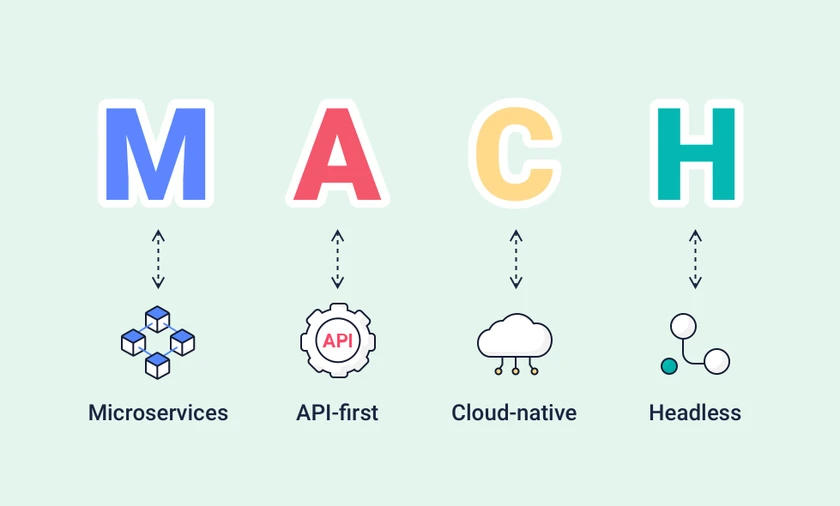
Outstanding scalability and flexibility
MACH architecture allows ecommerce businesses to quickly add necessary features, handling traffic spikes during peak times without spending too much effort or too many resources. This has outstanding value in both cost-effectiveness and performance optimization.
Enhance user experience
The headless aspect of the MACH architecture separates the front end from the back end, allowing for personalization of the user interface. Flexibility allows ecommerce businesses to create intuitive, consistent, and engaging shopping experiences across multiple platforms and channels. From websites, mobile devices to IoT, everything is perfected when put to use for customers, increasing loyalty and satisfaction.
Improved integration
The APIs-first nature of the MACH architecture ensures seamless integration with third-party services and existing systems. This capability is especially valuable for ecommerce businesses that connect to multiple payment gateways, use a variety of shipping services, and have a variety of marketing tools. The customer experience will also be much enhanced with this.
Technical error recovery and isolation capabilities
Leveraging cloud-based infrastructure, the MACH architecture provides efficient auto-scaling, troubleshooting, and fault tolerance. Worries about the entire ecommerce business system collapsing or being seriously affected will be completely dispelled. Your digital store will continue to operate as usual even in the face of unexpected disruptions. Revenue and excellent customer experience will not be materially affected.
Some Challenges when Using MACH Architecture You Must Know
MACH architecture is an architecture that promotes initiative and empowers business owners throughout the process of operating and improving ecommerce stores. Based on observations from a team of experts with experience operating MACH architecture, we will list some challenges and solutions below:
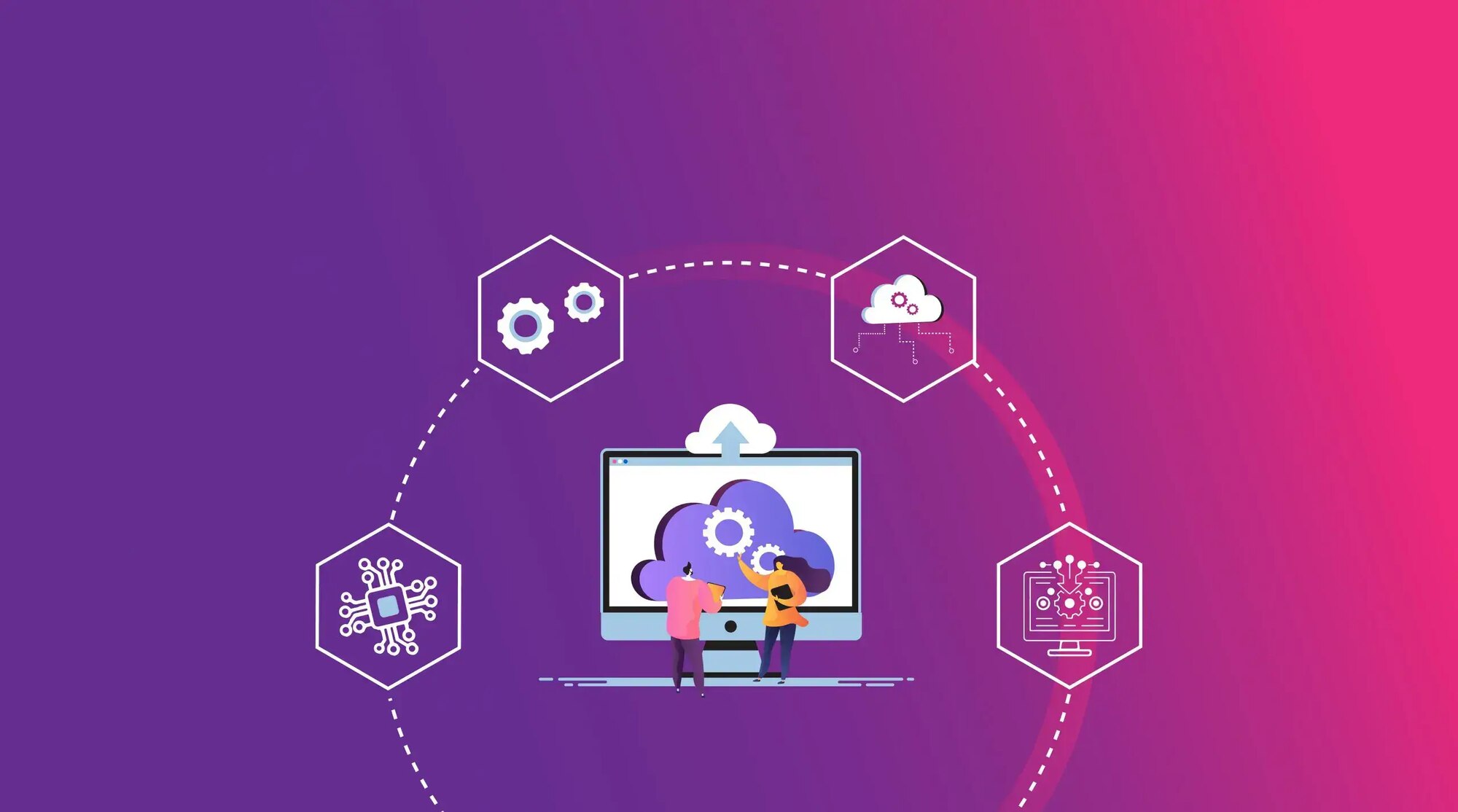
Management complexity
Managing multiple microservices in a MACH architecture can be extremely complex, especially as ecommerce businesses grow dramatically and the number of required features increases. Updating, monitoring and ensuring all microservices operate effectively and smoothly requires truly strong management measures.
Solutions: Deploy management processes intelligently by applying DevOps methods and tools. Use automation to ease deployment and monitoring.
Lacks front-end interface
Implementing headless elements in MACH architecture can lead to many challenges, especially related to the lack of available front-end interfaces. Businesses must proactively search for front-end interfaces or seek consulting agencies to own a truly satisfactory interface. This can impact uptime, affecting resource allocation to ensure seamless integration between the user interface and the microservices of the digital stores system.
Solutions: Realize the importance of front-end development early and seek advice from experts with experience working with headless architecture. Leverage existing frameworks and front-end tools to accelerate development with compatibility with the MACH architecture. Prioritize elements that work on their modular and reusable nature for future user interface improvements.
Expensive and difficult in the initial implementation process
MACH architecture brings many benefits, but that is the story that happens when the business owner and internal team are familiar with the operating circuit. In fact, in the beginning, the implementation process can be extremely challenging and expensive. Existing factors are likely to react negatively when the migration process takes place. Investment costs, resource allocation and the possibility of disruption over a certain period of time can also hinder business performance.
Solutions: Carefully analyze the costs – benefits – time needed to prove the long-term benefits of MACH architecture for your own ecommerce business. Carefully plan and divide the cost frame – specific time to convert digital businesses to MACH architecture. At the same time, consider taking advantage of specialized knowledge or external services from a trusted partner to optimize the migration process and ensure optimal performance when officially put into operation.
Case Studies of Using MACH Architecture
Amazon

Amazon – an ecommerce platform with worldwide coverage – started using MACH architecture in 2006. This brand has successfully implemented a series of innovations with MACH architecture such as Amazon Echo IoT and Dash ordering. The ability to deploy code services in just 11.7 seconds without interruption also elevates the level of service rigor for customers. Amazon continues to assert its superior position to this day, with the help of MACH architecture.
Foodl
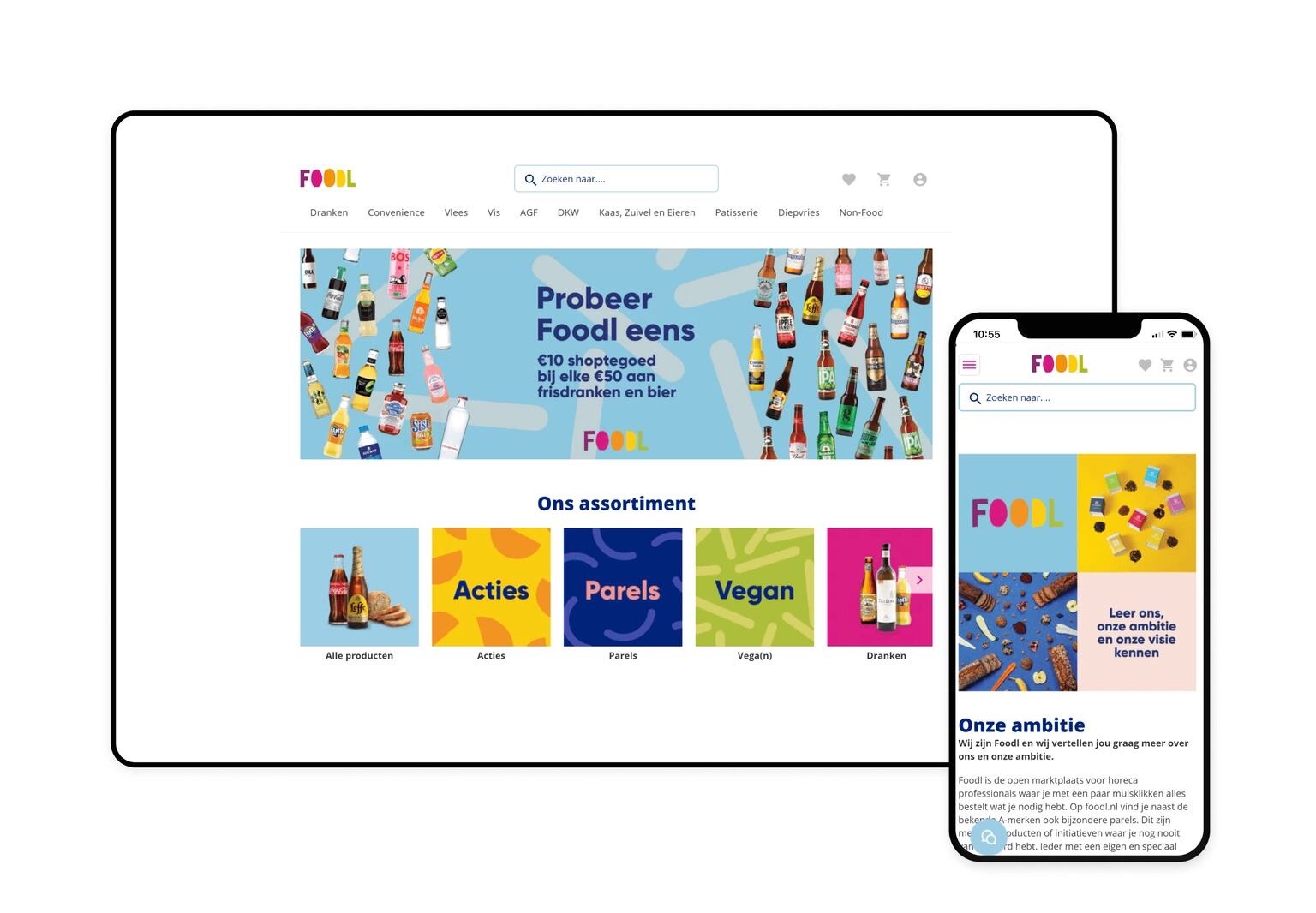
Foodl is a B2B online marketplace serving the HoReCa industry. Foodl successfully leverages MACH architecture to continuously upgrade user experience, driving a human-centric way of working. Foodl confidently adjusts deployment technologies throughout the operating process, allowing flexible expansion and customization to personalize the user experience.
Uber

Uber switched from a monolithic platform to a MACH architecture, quickly receiving a lot of positive feedback with outstanding improvements in service provision. MACH architecture allows Uber to independently update specific components, ensuring timeliness and superior quality of innovations. This helps Uber continuously maintain its position as the largest ride-hailing platform in the world, while enhancing its competitive advantage in the transportation industry in general.
Conclusion
MACH architecture is a popular form of operation for businesses, especially when entering an ecommerce platform requires more than just a simple digital storefront. It stands out with its outstanding flexibility and scalability, along with giving ecommerce business owners proactive control over building their stores. However, there is no denying the difficulties and complexities in the process of learning about MACH architecture and how to put it into effective operation in your business in practice.
AHT Tech is a trusted company where you can seek valuable advice from experts or empower operations to optimize business performance, with MACH architecture. We have successfully implemented 1000+ ecommerce development projects, with +500 professional experts and being a trusted partner of more than 25 global ecommerce platforms.
Don’t forget to contact us as soon as possible and watch the video below for more detailed information about our ecommerce service:


